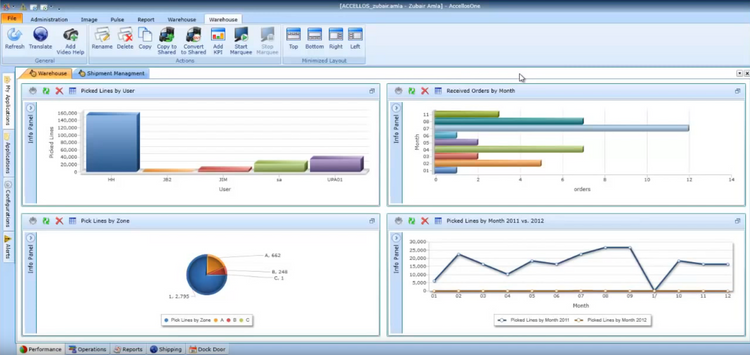Warehouse Automation Systems | Benefits and Best Practices
Warehouse automation is the growing process of replacing human workers in the supply chain with robots, vehicles, and other automated technology systems. An advanced automation system compiles all these different warehouse management software (WMS) features into one comprehensive platform.
How Does Warehouse Automation Work?
Warehouse automation systems work by streamlining warehouse operations through software and hardware tools. Automation technology used to mean conveyor systems and nothing more. As automation technology continues to improve, there are more and more ways to utilize it in a warehouse setting:
- Scanning hardware
- Conveyors and carousel systems
- Storage and retrieval
- Pallet and bin placement
- Robotics systems
- Self-driving or automated guided vehicles
- Drones
A software system can optimize all of these technologies. Warehouse automation systems can integrate with WMS and warehouse execution systems (WES) for a fully controlled warehouse environment. The first provides control over inventory within the warehouse. The second handles on-site product picking, distribution, and storage. Warehouse automation software can integrate or replace WMS, WES, warehouse control (WCS), transportation management (TMS) into one comprehensive system.

Why Use a Warehouse Automation System?
There are many benefits to using WMS software to automate your warehouse processes:
More Accurate Order Picking
Imagine a warehouse stores clothing for a specific distributor. There are two different pink shirts offered in a similar style. One worker places a returned pink shirt into the wrong bin. Another worker then grabs that incorrect shirt to fulfill a new order. The end result is an unhappy customer and another returned shirt.
In a warehouse, human error is to be expected. These small errors happen all the time. Pickers can grab the wrong product for a variety of reasons. Delivery drivers can go to the wrong house or business. Unfortunately, every order fulfillment mistake can add up over time and take away from your revenue.
Warehouse automation with traceability tools and AS/RS systems cut down on this type of human error while improving your overall inventory management. Incoming items are always scanned in, reducing the chances of products being sorted into the wrong bins. This in turn reduces the likelihood of the wrong product being picked and delivered to customers.

Streamlined Multi-Echelon Supply Chain Operations
The multi-echelon supply chain is incredibly fragile. All it takes is one unexpected delay anywhere along the line to cause a long-lasting, expensive chain reaction. Your incoming and outgoing processes need to be in perfect sync to maintain storage equilibrium.
One source of delay is labor shortages at warehouses. You can fall days or weeks behind schedule whenever your distribution center is short staffed. Of course, automated robots are faster than human workers and available 24/7. And you can use robotics in addition to your human workers in order to speed up labor during peak demand. During holiday rushes, automated robots can keep working even after your warehouse employees go home.
Reduced Maintenance and Downtime for Repairs
Delays can also be caused by downtime for hardware repairs and upgrades. Warehouse automation systems can track the different robots, vehicles, and hardware used at your warehouse by using preventive maintenance software.
Tracking software can determine which of your self-driving cars are in need of general maintenance before they experience mechanical breakdowns. The same goes for robotics, conveyors, storage and retrieval machines, and other warehouse hardware. The cost savings from avoided downtime can go right back into your company.
Create a Safer Warehouse Environment
Another benefit of warehouse automation for your employees is creating a safer work environment. As long as there are people operating machinery, there’s a chance for injury to occur. Supply chain risk management begins by automating the warehouse. Using robots and self-driving vehicles can cut down on accidents involving your human labor force. Reducing risk can lead to lower insurance costs, improving your bottom line.
For example, food products often have to be stored in freezers to avoid expiring before being delivered. Labourers who regularly go into the freezer require protective equipment to stay warm and can only be exposed to freezing temperatures for so long to avoid potential injury. Robotic storage and retrieval machines can work in sub-zero environments for extended periods without damage.
Automation through WMS can make your warehouse safer, more cost effective and productive. Consider using a WMS in order to start optimizing operations.
Need help choosing a WMS software to automate your warehouse? Get free help from one of our software advisors.
